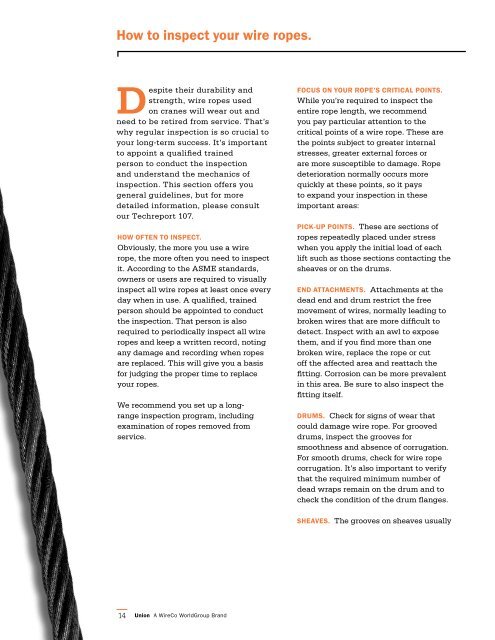Crane User's Guide - Union Wire Rope
Crane User's Guide - Union Wire Rope
Crane User's Guide - Union Wire Rope
You also want an ePaper? Increase the reach of your titles
YUMPU automatically turns print PDFs into web optimized ePapers that Google loves.
how to inspect your wire ropes.<br />
despite their durability and<br />
strength, wire ropes used<br />
on cranes will wear out and<br />
need to be retired from service. That’s<br />
why regular inspection is so crucial to<br />
your long-term success. It’s important<br />
to appoint a qualified trained<br />
person to conduct the inspection<br />
and understand the mechanics of<br />
inspection. This section offers you<br />
general guidelines, but for more<br />
detailed information, please consult<br />
our Techreport 107.<br />
how often to insPeCt.<br />
Obviously, the more you use a wire<br />
rope, the more often you need to inspect<br />
it. According to the ASME standards,<br />
owners or users are required to visually<br />
inspect all wire ropes at least once every<br />
day when in use. A qualified, trained<br />
person should be appointed to conduct<br />
the inspection. That person is also<br />
required to periodically inspect all wire<br />
ropes and keep a written record, noting<br />
any damage and recording when ropes<br />
are replaced. This will give you a basis<br />
for judging the proper time to replace<br />
your ropes.<br />
We recommend you set up a longrange<br />
inspection program, including<br />
examination of ropes removed from<br />
service.<br />
14<br />
foCUs on yoUr roPe’s CritiCal Points.<br />
While you’re required to inspect the<br />
entire rope length, we recommend<br />
you pay particular attention to the<br />
critical points of a wire rope. These are<br />
the points subject to greater internal<br />
stresses, greater external forces or<br />
are more susceptible to damage. <strong>Rope</strong><br />
deterioration normally occurs more<br />
quickly at these points, so it pays<br />
to expand your inspection in these<br />
important areas:<br />
PiCk-UP Points. These are sections of<br />
ropes repeatedly placed under stress<br />
when you apply the initial load of each<br />
lift such as those sections contacting the<br />
sheaves or on the drums.<br />
end attaChments. Attachments at the<br />
dead end and drum restrict the free<br />
movement of wires, normally leading to<br />
broken wires that are more difficult to<br />
detect. Inspect with an awl to expose<br />
them, and if you find more than one<br />
broken wire, replace the rope or cut<br />
off the affected area and reattach the<br />
fitting. Corrosion can be more prevalent<br />
in this area. Be sure to also inspect the<br />
fitting itself.<br />
drUms. Check for signs of wear that<br />
could damage wire rope. For grooved<br />
drums, inspect the grooves for<br />
smoothness and absence of corrugation.<br />
For smooth drums, check for wire rope<br />
corrugation. It’s also important to verify<br />
that the required minimum number of<br />
dead wraps remain on the drum and to<br />
check the condition of the drum flanges.<br />
sheaves. The grooves on sheaves usually


